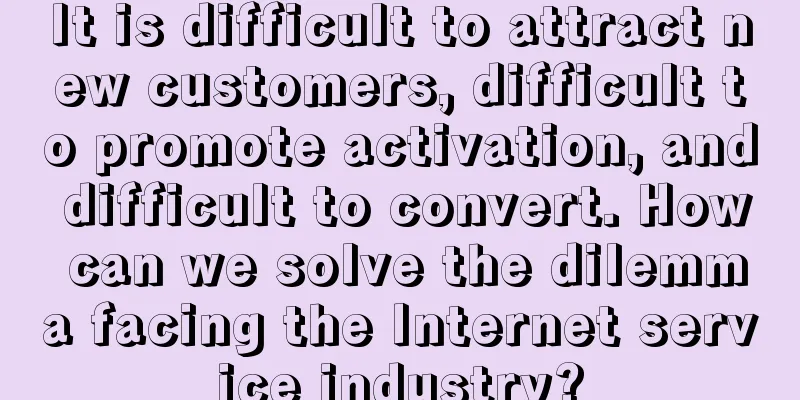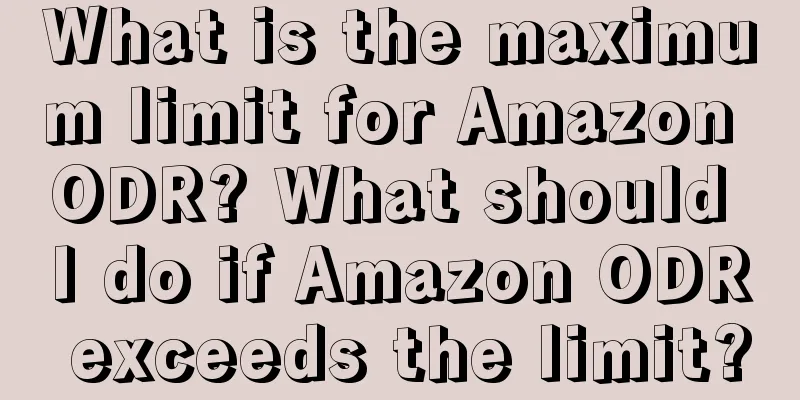It is difficult to attract new customers, difficult to promote activation, and difficult to convert. How can we solve the dilemma facing the Internet service industry?

Even today, the Internet industry is still full of changes. A new round of competition that may change the landscape has been set off in the local life sector, with TikTok and Kuaishou stirring up the competition, and Meituan, Didi, Ctrip, AutoNavi and others all coming up with unique strategies, and the business scope of super apps continues to expand; in the content field, whether it is long or short videos or information reading, everyone has entered a stable period at the top, and in order to maintain the hard-earned market share, each of them dare not relax at all, and hot products are frequently released. Going against the current, if you don’t move forward, you will fall behind. Although Internet practitioners still maintain high-intensity efforts and actively seek change, the conversion effect after "tossing" is not as satisfactory - users are not as easy to get as before, the overall market growth has slowed down, and the growth rate of monthly active users/daily active users/arpu value has also reached a bottleneck. It is difficult to increase the volume, the existing volume is frozen, and low-frequency users are dormant. Improving the efficiency of the conversion link is imminent. The desire to grow is not dead, but it is difficult to grow and realize. The "buying volume method" regarded as the secret code of the Internet business model has also encountered the problem of high prices and low ROI. In the context of reducing costs and increasing efficiency, the trial and error range that all companies can tolerate is shrinking, and business operations are a protracted battle. Should we focus on traffic and survive in the present? Or dance with uncertainty and bet on the future? Or should we take into account both short-term and long-term benefits? The Internet service industry has come to a crossroads where it has to demand “this and more.” 1. Marketing Operation: Not only attracting new customers, but also attracting active customers"We want both, and more," which means we need to attract new users and find growth in a market that has reached its peak; we also need to stimulate and activate existing users; and we also need to achieve immediate conversions. Wang Shui, director of the Advertising Department of Capital University of Economics and Business, believes that the current scale of Internet users has reached a growth bottleneck, and the average online time per person has also begun to decrease. The supply has decreased, but advertisers still have a very large demand for traffic, and supply is insufficient to meet demand, so traffic costs have risen. Once traffic costs rise, advertisers have become particularly strict with their requirements for post-link effects, and both platforms and advertisers are becoming more and more competitive. He observed an obvious trend - marketing operations, that is, marketing operations. Advertising marketing does not only exist to attract new customers, but also to track the entire life cycle of users to release LTV (Life Time Value). In fact, today's users are becoming more and more "cautious". In the past, a single contact was enough to attract new customers, but now multiple contacts are needed, and long-term companionship is needed to build trust; the past extensive traffic growth methods also need to be further extended and explored - in terms of time, from a single meeting to the entire life cycle, in terms of space, from a single contact point to multiple conversion opportunities, and the ceiling of "traffic buying and selling" can be broken through through refined operations. Liu Peng, the author of "Computational Advertising", further explained the idea of marketing operation. Taking the game industry as an example, the game industry generally limited growth to activating apps for users. However, in fact, a large part of the seemingly "activated" users cannot form real activity in the end. Some of them jump in through ads and jump out quickly. Then, if we use refined marketing and operationalize marketing, we can make users feel involved through user activities, coupons and other operational methods. The cost of "pulling activity" here is much lower than "pulling new" users. Let's use an elementary school word problem as an intuitive analogy: a pool is filled with water, and water is leaking out at the same time. If the filling speed is much lower than the leaking speed, the pool will soon dry up. This is like a user's "traffic pool". Marketing and attracting new users is like filling the pool with water, but the price of water soars and the water flow becomes thinner. Marketing operations are to reduce leakage as much as possible and activate existing resources. Of course, the actual marketing process is not as simple and linear as filling and leaking a pool. In addition to reducing losses, marketing operations can also allow user word-of-mouth to automatically ferment, form a private domain effect, leverage, and even be equivalent to "conveniently" doing brand building, building brand power, and achieving product and effect synergy. Huang Lei, general manager of Tencent Advertising Industry Sales Operations, believes: "Buying advertisements is like paying the water bill and turning on the tap, and traffic comes. But if you don't pay, there will be no water. The formation of private domains is like digging a well yourself, which is very difficult, but once you dig it, your traffic becomes 'retained' traffic, which can be used at any time without paying. We can bring such long-term value to advertisers." Marketing operations have resolved the shackles of internal traffic and suspension of investment and effectiveness. The solution can also be seen in some practices. Coca-Cola, Unilever, Great Wall Motors and others have established CGOs, where G stands for Growth. Growth is the overall goal, and marketing and operations are inseparable. This means that our "top-level design" is thinking comprehensively, "buying volume" from a global perspective, and "retaining volume" with operational methods, saying goodbye to the path dependence of extensive growth in the past, setting fine anchor points in each convertible link, operationalizing marketing, and ultimately unifying goals to achieve operational growth. 2. Growth and Operation Integration: A New Solution Called for by the Network Service ModelA few years ago, Qutoutiao CEO Tan Siliang shared a formula with me - it costs n yuan to acquire a user, and the ARPU value that can be generated after the user comes is m yuan. As long as m is greater than n, profit can be generated. This is the core rule of Internet service platforms in their rising period. Taking the reading industry as an example, many practitioners treat the reading business as a math problem: n yuan is spent on investment, and users pay m yuan. If m is greater than n, they make money. But the Internet is open. Once your material starts to gain volume, your peers will soon be able to see it. Then everyone will roll inwards and push up the price of traffic. The cost of traffic continues to rise, and gradually, m equals n, and m is less than n. In addition, the "amnesia" behavior of reading users is becoming more and more typical. They are reading in the app, but are suddenly distracted by other things. Then they forget where they were reading, and even forget that they downloaded the app. At this time, it is not enough to wake up users by relying on in-app operations alone, and external advertising must be used to get users to jump back in. In the local life track, existing players are basically the top "big players" who do not need to "break the ice" with users. Therefore, their focus is not on acquiring customers, but on promoting activation and conversion, and increasing the purchase frequency and average order value of existing users. “In the past, for life service clients, the advertising part of the link would end after the user clicked on the ad and downloaded the app,” said Huang Lei. But now, Tencent Advertising needs to communicate and research with clients from the early stages of the project, and provide clients with project suggestions through its own data insights, including what kind of materials to push at what marketing nodes to give users greater value, making it easier for clients to achieve conversions, etc. From this point of view, whether it is online content consumption such as reading, long and short videos, or service consumption that requires offline fulfillment such as takeout and local life, the idea of marketing operation is also applicable. Today's advertisers' demands are not just "buying volume". From attracting new customers to promoting activation to conversion, marketing and operation are integrated and each step needs to be more refined. How to do it specifically? Leveraging a larger platform and more professional technology is a shortcut. Let's talk about technology first. The progress of Martech (marketing technology) has brought us more accurate advertising effects, but technology itself is not the goal. The efficient matching between advertising and people, advertising and intention is the core demand. In this regard, the "commoditization" idea proposed by Tencent Advertising is worth a look - transactions in the Internet service industry revolve around games, short videos, graphics and other content, as well as various local life services, but we can regard these transaction targets as "commodities" and sort out finer-grained features for different commodities to match the different characteristics and needs of users. In the past few years, the marketing industry has continuously refined user segmentation with the help of cutting-edge technologies such as digital advertising systems and big models, but has neglected the refined operation of its own products. In the context of extensive marketing, we only know how to push coffee ads to office workers, but we have not refined the matching of "people" and "goods". If you like American coffee, I can't recommend you vanilla latte. If you never buy sweets, my snack coupons are meaningless. Commercialization is a step forward for advertising technology. Its underlying logic is to operationalize and refine marketing, improve matching, and reduce ineffective losses. According to data shared by Tencent Advertising, in the reading track, the proportion of commercialized advertising has reached 50%. Only with the correct matching relationship, coupled with technical capabilities such as AI big models, can you accelerate in the right direction. Looking at the platforms, at first glance, the products of various advertising platforms are not very different, but if you look closely, you will find that the platforms have very different ideas. Take Tencent Advertising as an example. They think more about the power of marketing from the perspective of operating the entire chain. For example, in the past, advertisers paid more attention to the optimization target of the first-day ROI, but now advertisers can set the optimization target of the seven-day ROI in Tencent Advertising. In addition, Tencent Advertising has also created new deep bidding tools such as pay-per-view, activation and retention double bidding, key behaviors, etc., and continuously improves the achievement rate. To put it simply, advertisers can set both shallow and deep bids at the same time, one is the bid on activation, and the other is the bid on the second retention. Deep bidding is the core optimization goal, but when data is insufficient, the cost of shallow conversion should be guaranteed first. This will improve competitiveness in the bidding advertising market, thus greatly improving the "difficulty in increasing volume and low quality" problem that many advertisers are worried about. Another example is the marketing operation mentioned above, which returns to users and "people". Enterprise WeChat, WeChat groups, public accounts, video accounts, mini programs... Tencent's global ecosystem has too many touchpoints and scenarios for interacting with "people". From a spatial perspective, they have a wide coverage and rich layers. From a temporal perspective, they have a long user time, spanning the entire life cycle of user online behavior. For advertisers, this means that in addition to being able to successfully reach users, they can also "accompany" users to achieve multiple business needs such as awakening, activation, conversion, and monetization. Recently, I had a conversation with Guo Qing, former executive chairman of Meituan’s sales committee and head of Meituan’s hotel and travel department, about a similar topic - the sales and marketing strategy of a business is not static, and it must be adjusted at different stages of development. During the offensive phase, market share should be seized, rapid expansion should be achieved, and efficiency should not be overly concerned. During the development phase, market share should be basically stable, and efforts should be made to increase revenue and reduce expenditure, focus on efficiency and profits, and move towards refinement. The Internet industry does not lack growth opportunities in attracting new users, promoting activation and conversion, but the low-hanging fruits have been picked, and the growth opportunities need to be "reached". From dividend-based growth to profit-based growth, the era has shifted quietly. Internet services have experienced many ups and downs and have also come to this intersection where they need to turn around. Author: Liu Yalan, Source: WeChat public account: "Shen Xiang" |
<<: Top 10 trends in marketing
>>: "Speculative" people flock to the live broadcast room of scratching blind boxes
Recommend
What are the three types of logistics services on AliExpress? What are the differences?
As the world's leading B2B cross-border e-comm...
How to learn how to sell cross-border e-commerce products? What are the skills?
You can actually open a store on a cross-border e-...
Official accounts suddenly upgraded their “publish” function. Has WeChat come to its senses?
Recently, the official account was updated again, ...
The new top star “Wanyan Huide”: How did he achieve the “meme carnival” on the Internet?
Amid the Internet frenzy, is the next "Wanyan...
How to register on Facebook? How to use it in China?
In today's highly developed and popular social...
In 2023, what else can companies do to acquire customers online at low cost?
Corporate marketing has always faced an old proble...
Mixue Ice City has become a prominent brand of new tea drinks
There is no circle that the Snow King cannot squee...
What is the difference between Amazon VC and VE accounts? Which one is better?
On the Amazon platform, sellers can choose to use ...
The short play is free, who is consuming it?
Recently, with the help of ByteDance's traffic...
What is Wayfair? What is the difference between it and Amazon?
Now, although the threshold for opening an online ...
Practical tips: Discounts, buy-one-get-one-free, pre-sales, group buying, this is enough for membership marketing!
The current Internet business model has spawned a ...
How many days does Amazon’s overage inventory last? How to manage Amazon’s inventory?
When opening a store on the Amazon platform, you n...
What should I do if my Amazon IPI score reaches 400? How can I improve it?
When opening a store on Amazon, you need to pay at...
How do I get a Shopee buyer ID? What should I pay attention to when buying things on Shopee?
The development of Shopee stores is quite good now...
Xiaohongshu has defined the only path for private messages
"Xiaohongshu's new rules for private mess...






![6 popular article templates on Xiaohongshu|Just follow them [Industry templates V3.0]](/upload/images/67e6fa47dd20c.webp)


